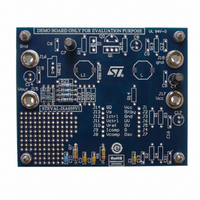STEVAL-ISA059V1 STMicroelectronics, STEVAL-ISA059V1 Datasheet - Page 8

STEVAL-ISA059V1
Manufacturer Part Number
STEVAL-ISA059V1
Description
DEMO BOARD BASED ON TSM108
Manufacturer
STMicroelectronics
Type
DC/DC Switching Converters, Regulators & Controllersr
Specifications of STEVAL-ISA059V1
Main Purpose
DC/DC, Step Down
Outputs And Type
1, Non-Isolated
Voltage - Output
6V
Current - Output
800mA
Voltage - Input
12V
Regulator Topology
Buck
Board Type
Fully Populated
Utilized Ic / Part
TSM108
Input Voltage
12 V
Output Voltage
6 V
Product
Power Management Modules
Silicon Manufacturer
ST Micro
Silicon Core Number
TSM108
Kit Application Type
Power Management - Voltage Regulator
Application Sub Type
DC/DC Converter
Kit Contents
Board
Lead Free Status / RoHS Status
Lead free / RoHS Compliant
Power - Output
-
Frequency - Switching
-
Lead Free Status / Rohs Status
Lead free / RoHS Compliant
For Use With/related Products
TSM108
Other names
497-8716
Available stocks
Company
Part Number
Manufacturer
Quantity
Price
Company:
Part Number:
STEVAL-ISA059V1
Manufacturer:
STMicroelectronics
Quantity:
1
TSM108
7. Standby Mode
In order to reduce to a minimum the current con-
sumption of the TSM108 when in inactive phase,
the Standby mode (!Stby pin of TSM108) imposes
a complete OFF state of the P-Channel MOSFET,
as well as a complete shut off of the main func-
tions of the TSM108 (operational amplifier, PWM
generator and oscillator, UVLO and OVLO) and
therefore reduces the consuption of the device.
The !STBY command is TTL compatible.
8.Power Transistor: P-channel MOSFET or
PNP Transistor?
The TSM108 can drive, with minor external com-
ponents change, either a P-channel MOSFET, or
a PNP transistor. The user can choose the type of
external power element, nevertheless, here fol-
lows a few considerations which will help to take
this decision
The following figures shows two different sche-
matics where both driving abilities of TSM108 are
shown. The third schematic shows how to improve
the switch off commutation when using a bipolar
PNP transistor.
P-channel MOSFET
8/13
MOSFET P
GD
Q1
TSM108
D1
L1
PNP transistor
The most immediate way to choose between a
P-channel MOSFET or a PNP transistor is to con-
sider the ratio between the output power of the ap-
plication and the expected components price: the
lower the power, the more suitable the PNP tran-
sistor is; the higher the power, the more suitable
the P-channel MOSFET is. As an example, for a
DC/DC adaptor built for 12V/6V, the recommend-
ed limit to choose between P-channel Mosfet and
PNP transistor is around 200mA.
Below 200mA, the price/performance ratio of the
PNP transistor is very attractive, whereas above
200mA, the P-channel Mosfet takes the advan-
tage.
9. Calculation of the Passive Elements
Let's consider the following characteristics for a
Cigarette Lighter Cellular Phone Battery Charger:
Vin = 12V - input voltage of the converter
Vout = 6V - output voltage of the converter
F = 100kHz - switching frequency of the converter
adjustable with an external capacitor
Iout = 625mA - output current limitation
GD
Q1
Q1
GD
TSM108
TSM108
D1
D1
L1
L1




















